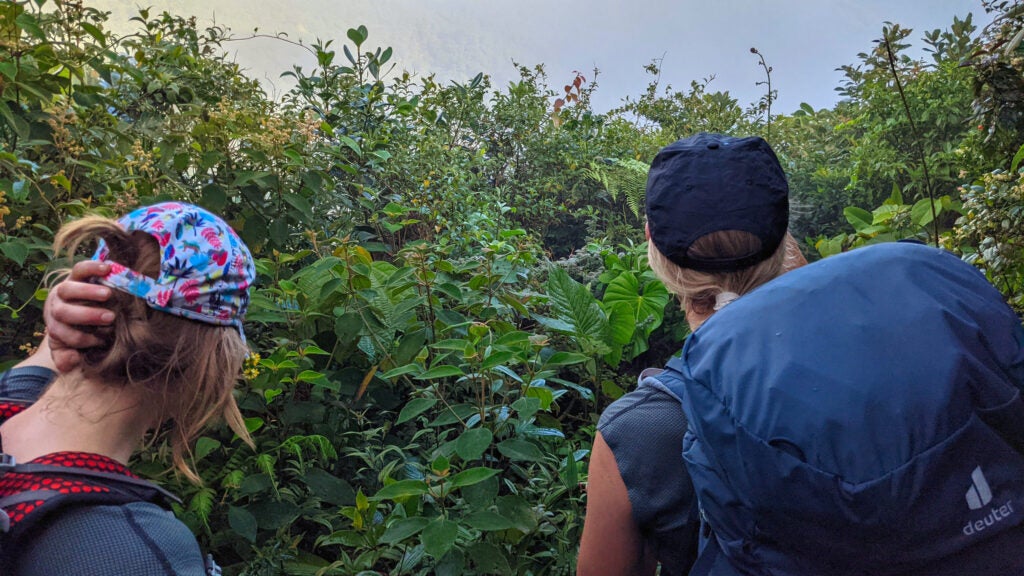



I made a lot of mistakes the weekend that I hiked Champaqui, but underestimating the rain was the worst by far.
I was 21 years old and finishing up a semester abroad in Buenos Aires, Argentina. With classes over and weeks left until I headed home, I decided to take a trip out west to spend some time in the mountains and get away from the city’s crowds, smog, and nonstop hustle. After a little research I settled on the Sierras de Córdoba, a forested and shrubland-covered range of rolling peaks pock-marked with reservoirs and faux-Alpine tourist villages near the country’s geographic center.
Working off guidebooks and a map I printed from the internet, I traced a 33-mile, horseshoe-shaped route from the small community of Villa Alpina, up and over Champaqui—the highest peak in the range at just over 9,000 feet—and back down to the town of Villa Yacanto.
While I had hiked and camped my whole life, this would be my first real backpacking trip. I spent a few days gathering gear, then hopped on a bus for the 14-hour trip to Cordoba. The next morning, after checking in at the local tourist office, I caught a taxi to the trailhead, recorded a video for my vlog (don’t look at me like that; it was the aughts) and hiked into the woods under blue skies.
A few hours later, everything went wrong at once. The clouds began to thicken and coalesce, wrapping the ridges in a dense, gray fog, and dropping the temperature. Then, it started to drizzle. After taking a detour to snap pictures of a waterfall from a lookout above, I turned around and realized I couldn’t find my way back to the unmarked and unsigned trail. For the next few hours, I wandered in circles looking for the path as the drizzle turned into a torrent. Making matters worse, I was wearing jeans; while I had a pair of quick-dry shorts tucked into my pack, my denim pants immediately soaked through.
When I finally gave up and decided to make camp, I discovered that my bargain-bin tent had a rainfly roughly the size of a bandana, allowing precip to sneak through the peak vent with every wind gust. I spent that night curled in a ball on my sleeping mat with my space blanket wrapped around me, watching rivulets of water snake down my tent’s wall and pool on the floor.
It’s been more than a decade since my misadventure in the Argentine mountains, but as Backpacker’s editor, I’m still nervous about sharing the story with you. I messed up, and to a lot of backpackers online today, messing up is just about the worst thing someone can do. Read the Facebook comments on any news story about a hiker who needed rescue, and you’ll see other hikers calling them irresponsible, demanding they pay the cost of their own rescue, or even suggesting that SAR should have left them there. You get the impression that for some hikers, mistakes aren’t just a technical failure, but a moral one, a symptom of some kind of intrinsic flaw in the person who makes them.
There’s more than online mobthink behind this. For many people, tearing apart hikers who make mistakes seems to be a kind of defensive mechanism—a way of reassuring ourselves that bringing the wrong gear or losing the trail is something only irresponsible morons do. Because we’re basically responsible, smart people, we’re safe.
The problem is, that isn’t true. Every hiker makes mistakes, and everyone who has hiked for long enough has made at least a couple that could have been quite dangerous if things had broken differently. Having good mentors can help, but even the best-taught hikers screw up: It doesn’t matter whether you learned to backpack from NOLS or BSA, we all eventually graduate from the school of FAFO.
If experienced hikers were more honest about our bad decisions, I think it would go a long way towards making backpacking safer. For newer hikers, hearing about vets’ mistakes is both educational and reassuring, a reminder that the most grizzled hikers started from zero once upon a time and that messing up is just part of the journey. And for hikers who have been in the game longer, talking about our mistakes is a powerful reminder that we’re not perfect either, and that we still need to be alert for our own missteps.

Let me take a deep breath and I’ll take you on a tour of my own long career of outdoor mistakes. On a hike in New Hampshire when I was 13, I accidentally led my two younger cousins down the wrong side of Mt. Chocorua, sparking a 4-hour family rescue mission that only ended when I begged a gift shop to let me use their landline to call my parents. In my 20s, I bullheadedly tried to go winter backpacking in Wyoming’s Medicine Bow range and instead had to stumble through the entire slushy loop in one night after I couldn’t find a place to camp. I’ve been benighted more times than I can count. But my masterpiece of mistakes—my personal The Great Gatsby of screwups—was when my partner and I took a wrong turn during what was supposed to be a 4-hour climbing trip on the Arizona/Mexico border and were too pigheaded to just give up and turn around. While we did eventually summit our objective, we spent two full days wandering through the desert. By the time we got back to the car, we had cuts on nearly every exposed part of our bodies from crawling through cactus and ocotillo, and our clothes were torn into rags.
My experiences may be unique, but they’re not unusual. When I asked my colleagues they rattled off their own misadventures in the wilderness. One Backpacker editor told me about how he tried to take shelter under a widowmaker during a storm, only for a lightning strike to hit the next tree over and send its branches crashing to the ground on fire. Another got stuck for 16 hours on a forest road after picking a bad place to turn her car around. And an Outside editor shared the story of the time she gave herself heat exhaustion trying to make miles on a shadeless stretch of the Camino de Santiago. You already know what your own mistakes are: Maybe you started a summit hike too late in the day and ended up having to descend in a thunderstorm; maybe you made a wrong turn and spent hours trying to find your way back to the trailhead; maybe you didn’t bring enough layers and shivered through your trip.
There are exceptions—mistakes you should genuinely be embarrassed about. If you have to get rescued from the same mountain twice in two days, that’s on you. If you need someone to tell you not to approach bears, that suggests some deeper issues with your judgment that go beyond hiking. If you present yourself as a guide or a trip leader, your safety practices had better be as close to perfect as possible. And yes, honest mistakes on the trail can have consequences, sometimes serious ones: Experience is an effective teacher, but unlike most teachers nowadays, it still uses corporal punishment. But if anything, that just makes mistakes more crucial to destigmatize. The more we talk about them, the more people will learn and adjust their behavior to avoid making those same missteps themselves.
Besides, in the end, most mistakes don’t kill or maim hikers: They’re just bad decisions that we learn and move on from, maybe with another interesting campfire story.
When the rain let up the next morning in Argentina, I managed to backtrack to a local farmer’s guest house, where I found a bunk bed and ate a hot meal with a youth group that was on their way back from the same trek. The next morning, I asked the farmer’s son to point me back toward the trail, the sodden pasture squishing under his rubber boots as I followed him up the hill behind the house. My wet jeans never did dry: For next two days, they hung from my pack’s top lid as I followed the trail west, stopping to watch tadpoles wiggle around puddles, rock-hopping across creeks, and snapping pictures of travelers’ shrines built into natural grottoes in the rock. They were still there as I watched the clouds break from Champaqui’s summit, a little life lesson that hadn’t stopped me in the end.
From 2024

